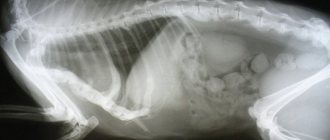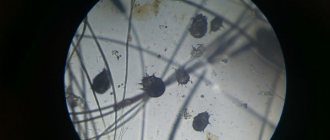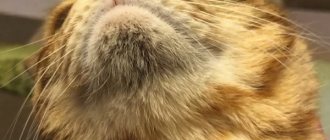Urolithiasis (urolithiasis) in cats - a disease accompanied by the formation and deposition of urinary stones or sand in the renal pelvis, bladder or urethra. Usually accompanied by painful urination, blood in the urine and frequent urge to urinate. The disease progresses quickly and leads to the death of the animal.
The causes of urolithiasis in different sick cats are different, that is, this disease is polyetiological.
Currently, the number of cats with urolithiasis has increased sharply and relapses are observed in 50-70% of cases.
According to some researchers, most often one-year-old cats suffer from urolithiasis; according to others, it is more often observed in the 2-3rd year of life.
The disease is equally common in both male and female cats . Cats are more predisposed to urolithiasis due to the specific anatomical structure (narrowness of the urethra), and it is more severe, as it is often complicated by bladder obstruction.
Main causes of kidney disease in cats
Kidney disease is a common problem in cats, affecting more than 1/3 of older cats. There are a number of reasons that may affect different age groups and have different consequences. Ultimately, unfortunately, chronic kidney disease (occurs over time) or acute kidney injury (occurs suddenly) will always have the same result—the cat will be sick. Signs of illness in your cat reflect the inability of the kidneys to perform their many functions well enough.
Below you will find a brief description of the ten most common causes of kidney disease. These are the goals of your veterinarian's diagnosis.
Signs of kidney stones
Urolithiasis in cats manifests itself in the formation of two types of stones: struvite and oxalate. The former are formed in an alkaline environment and have a solid structure. Alkalinization of urine is mainly due to excess phosphorus and magnesium in the cat's food.
The second type occurs if the pH of the urine is highly acidic, which is caused by an increased calcium content. Oxalates are characterized by the presence of sharp edges and a loose structure.
In order for the treatment of nephrolithiasis in a domestic cat to be successful, it is necessary to recognize the disease in time. Owners should carefully monitor their pet, paying attention to any little details. The main symptoms of nephrolithiasis, i.e., kidney stones, in cats are:
- painful discharge of natural needs;
- blood in urine;
- frequent urination in an unusual place;
- discomfort and/or pain in the abdomen;
- bowel dysfunction;
- frequent urinary tract infections with frequent relapses;
- lack of appetite;
- unnatural weight change (loss or gain);
- refusal to drink water;
- indigestion, vomiting;
- a sharp decrease in physical activity, lethargy, apathy;
- change in the cat’s character and habits;
- frequent manifestations of aggression.
It should be remembered that nephrolithiasis often occurs in cats without any external manifestations or signs. Therefore, your pet needs to be shown to the veterinarian periodically. A specialist will be able to recognize the disease and begin therapy in time.
In especially dangerous cases, for example, in the presence of very large nephrolites, treatment by surgical intervention is required. During the operation, the cat's kidney is cut with a special instrument and stones (nephroliths) are removed. In some cases, it may be necessary to remove the kidney completely. This method is called nephrectomy.
Surgical intervention is associated with a great risk to the life of a pet. Especially if the patient is severely weakened by illness and age.
After the operation, the cat must undergo a rehabilitation course of treatment and restorative procedures. This is carried out only in a veterinary clinic. Here the cat will be provided with the necessary treatment, food and care.
To prevent recurrent stone formation, the removed nephrolith must be examined in the laboratory. This will help you choose preventive measures to prevent a recurrence of the disease in your cat.
Infection of the kidney tissue (pyelonephritis)
Infection of kidney tissue by bacteria or, less commonly, fungal organisms is one of the kidney diseases that may have a more favorable outcome, so your veterinarian will be on the lookout. Our goal when treating pyelonephritis is to kill the bacteria that cause destructive inflammation. This should limit the progression of any chronic kidney disease or aid in recovery from acute kidney injury. Urine bacterial culture and susceptibility can determine the type of infection and determine which antibiotic may work best.
Renal obstruction (ureteral obstruction with hydronephrosis)
Kidney stones can fragment and travel through urine into the ureter, the long, narrow tube that connects each kidney to the bladder. They are likely to cause severe pain as they move, and significant difficulty in functioning results in the kidney if they become lodged in the ureter, causing partial or complete blockage. New urine cannot pass out of the kidney easily and it recedes, causing the kidneys to swell. If there is enough pressure, the kidneys become enlarged (hydronephrosis) and damaged. If both ureters become blocked at the same time, this can lead to catastrophic consequences, including death.
Main signs and symptoms
Males are more susceptible to urolithiasis than cats. Urolithiasis is common in castrated people, just like in their non-sterile counterparts. Castration is not one of the causes of the disease, but if it was done when the kitten was less than six months old, the animal’s urethra will remain underdeveloped. Urolithiasis will be severe; deposits will quickly clog the narrow lumen of the urinary canal. Topping the list of causes of urolithiasis in cats is improper metabolism.
Factors contributing to the occurrence of the disease:
- excess fish;
- fatty food;
- cheap feed;
- mixing regular food and feed in one feeding;
- lack of fluid, bad water;
- obesity, low activity;
- congenital disorders of the genitourinary system, heredity;
- infections, staphylococci, streptococci.
It is difficult to notice the disease at an early stage. Many owners begin to sound the alarm when they already observe obvious signs of urolithiasis in their cat, when the situation is close to critical. Without timely help, the animal may die, so it is important to take action without waiting for an aggravation. Pet owners need to respond to possible symptoms of urolithiasis in cats:
- the cat has become “sad” and moves less;
- the animal has lost its appetite;
- The cat behaves restlessly when urinating, approaches the litter box several times, does not urinate on the first try, and intensively licks the genitals.
Later, more serious symptoms appear:
- Urination becomes more frequent, the cat sits in the tray for a long time.
- Soreness appears, the cat screams while urinating.
- The urine turns pink and blood clots remain in the tray.
At this stage, the cat's life is already in danger. Salt deposits move along the urinary tract, stones get stuck in the urethra, the ducts become blocked, and fluid accumulates in the bladder, which leads to intoxication. If urine does not leave the body for more than a day, it is deadly. During illness, the cat’s bladder is distended, and the abdomen is greatly enlarged.
It is impossible to identify the main source of the pathology. Experts have identified many factors that result in urolithiasis in cats. The causes of this pathology are mainly related to poor nutrition, lifestyle, care, and heredity.
Most often the disease is caused by:
- genetic predisposition;
- congenital abnormalities in the development of the genitourinary system and anatomical features (too thin or long, as well as curved urethra);
- drinking water of poor quality containing many minerals, for example from a tap;
- diet with low fluid intake;
- disorders leading to decreased metabolism;
- dysfunctions in the digestive tract;
- mixing or alternating natural and industrial dishes (dry snacks, canned food) during the day or in one feeding most often provokes the appearance of metabolic disorders, as a result of which urolithiasis occurs in cats;
- excessive amounts of minerals in the diet, for example, with a large amount of fish or fatty foods;
- low-quality cheap feed;
- overfeeding leading to obesity;
- inactivity;
- infections (streptococcus, staphylococcus), injuries to the pelvic bones, inflammatory processes and neoplasms in the genitourinary organs.
Stones, i.e. nephrolites, occur in the kidneys of cats for various reasons. Among them are the following key points:
- infection of the urinary tract and/or kidneys;
- genetic predisposition;
- improper feeding of the animal;
- drinking water of poor quality;
- long-term use of medications to treat other diseases;
- impaired metabolism, i.e. metabolism.
Very often, kidney stones in cats are formed due to a tendency to irregular urination. Another important factor is the formation of urine with a high level of concentration of individual substances. Often, in parallel with nephrolithiasis, cats also develop urolithiasis, i.e. urolithiasis. In this case, stones form in the bladder and urinary system.
Slags
Many household items can damage your kidneys, not just antifreeze. Petals, leaves and pollen from lilies, even water in their vase, can cause serious kidney injury when cats nibble, lick or chew the flowers or come into contact with water. This is one type of flower that you should avoid completely if you have a cat! Common OTC medications such as aspirin, other nonsteroidal drugs (NSAIDs), or prescription drugs can all cause kidney disease. Cats, who are known for being picky about food and just about everything else, will still eat pills they find in your medicine cabinet or on the floor, so keep all medications in cat-proof containers. And always discuss the use of any medications with your veterinarian.
If you have any reason to believe that your cat has been poisoned, call your veterinary emergency number immediately for help. Contact us at the following numbers:
8-495-221-81-90
8-495-221-84-70
8-499-136-19-18
Symptoms
It is quite difficult to diagnose the disease when a pet just begins to have urolithiasis. Symptoms in cats at the primary stage are hardly noticeable to the owner. The animal simply becomes lethargic, shows less activity, eats worse and feels discomfort when urinating - these signs cannot always be compared with ICD. During this period, only a urine test will help recognize the disease.
The number and size of formations are increasing. They eventually begin to move, so they can partially or completely block the urinary duct. At this stage, the pet can easily be diagnosed with urolithiasis. Symptoms in cats or cats are obvious:
- due to acute pain during urination (dysuria), the animal meows on the tray;
- often runs to the toilet because he feels a constant urge (pollakiuria);
- the litter in the tray has reddish-pinkish tints instead of yellowish due to the presence of blood particles in the urine (hematuria);
- a complete cessation of urination is possible - the animal strains to no avail, and sometimes cases of rectal prolapse occur;
- upon palpation, you can feel that the abdomen has become tight and painful;
- urination in an inappropriate place, uncharacteristic for a well-mannered pet;
- signs of urolithiasis in cats also appear in behavior: the furry friend behaves persistently and fussily, trying to attract the attention of the owner, or, conversely, hides in a corner and cannot jump to a height;
- loss of appetite, rapid breathing.
We suggest you read: Tartar in cats treatment and removal
Damage to kidney filters (glomerular disease)
The glomerulus (the kidney's filtration mechanism) may be involved in feline kidney disease. Early on, we don't expect any signs of illness from this condition, but since glomerular disease can be caused by infections such as FIP/FeLV or cancer (among other things), time can make problems worse. Over time, inflammation in the glomerulus of the kidney damages the surrounding kidney tissue, creating chronic kidney disease, which makes your cat feel sick.
Treatment of urolithiasis in cats
If the diagnosis is confirmed, the specialist will prescribe a course of procedures aimed at alleviating the acute condition that causes urolithiasis in cats. He selects treatment individually, taking into account the degree of damage, advanced stage of the disease, age, gender and general condition of the patient. Today there are a number of special comprehensive measures that effectively relieve this disease and its consequences. There are two lines of solving the problem: conservative and operational.
Depending on the course of the disease and the severity, the specialist may prescribe stone removal using a catheter (catheterization) or surgical removal under general anesthesia. Catheterization is performed under anesthesia. First, sand or stone is removed from the urethra using a catheter, then the urethral lumen is treated with antiseptics.
Therapeutic procedures are prescribed to restore urinary outflow and relieve the inflammatory process that causes urolithiasis in cats. Treatment should not only eliminate pain, but also be aimed at prevention, eliminating relapses and complications.
Obstruction most often occurs due to muscle spasm, which is caused by irritation and mechanical damage to the mucous membrane of the urinary ducts. The animal is prescribed a course of medication that eliminates stagnation of urine and restores the patency of the ureters. For this purpose, sedative medications and antispasmodics (baralgin, spasmolitin, atropine and others), as well as antibiotics and homeopathy (magnesia, cantharis, apis and others) are used.
We invite you to read: How to sew clothes for cats with your own hands: diagrams
When visiting a veterinarian with an attack of urolithiasis in cats, treatment of the disease must begin with restoring the patency of the urinary tract. A catheter is used to remove urinary stones or clear out accumulated sand. All manipulations are performed under general anesthesia. After the formations are removed, the lumen of the urethra is thoroughly washed with an antiseptic solution.
In difficult situations, doctors must first create an artificial excretory duct - this intervention is called urethrostomy. However, for very large deposits that greatly exceed the diameter of the urethra, abdominal surgery is performed, directly removing the stones.
Further treatment is aimed at normalizing the acid-base balance in the pet’s body and cleansing it of toxic products. At the same time, the inflammatory process is eliminated by prescribing antibiotics and anti-inflammatory drugs. The total duration of therapy can be 14 days or more, depending on the complexity of the intervention, the condition of the animal and other circumstances.
For the treatment of urolithiasis, a mustachioed patient may be prescribed different groups of medications:
- painkillers (often Papaverine, Analgin);
- antibiotics (for example, Ceparin);
- medications that eliminate the inflammatory process (Palin, Furagin and others);
- antispasmodic drugs (Baralgin).
If necessary, maintenance therapy is indicated. These may be: vitamin complexes, drugs aimed at normalizing heart function, drugs to restore the digestive tract. All medications are prescribed only by a veterinarian in accordance with the age and gender of the cat.
Regardless of the complexity of the treatment (even if a cat’s urolithiasis was detected at an early stage), the pet’s future life should take place under constant preventive measures. The owner will be required to regularly examine the pet: submit urine for analysis and do ultrasound diagnostics of the urinary system.
In addition, the cat should be immediately switched to an appropriate diet that excludes components that provoke the development of the disease. If necessary, your mustachioed friend will need to be periodically given antibiotics and/or diuretics.
FIP or FIP (feline infectious peritonitis)
The kidneys are the main target for this severe inflammatory disease of domestic and feral cats. Some cats, especially young ones, develop a fever and effusions (fluid accumulation) in the chest or abdomen, but these quickly subside. Cats with non-effusive (dry) FIP tend to be older and show more subtle signs of the disease. Your veterinarian may become concerned about the possibility of FIP if the kidneys feel swollen and lumpy, lumpy (inflammatory cells can distort the outer layers of the kidney).
Proliferative glomerulonephritis
This is the name for inflammation of the kidneys (more precisely, their glomerular part is affected). Today it is believed that the disease has a pronounced heredity. Cases of acquired glomerulonephritis are extremely rare. No predisposition factors have been found; the disease occurs completely spontaneously. Very often, animals in the “prime of life” who have never suffered from pathologies of the excretory system get sick. Against the background of proliferative glomerulonephritis, lipoid nephrosis may occur, accompanied by degeneration and replacement of organ tissue with fat cells. The process is difficult and irreversible.
The development of nephrosis can be determined by the following signs: the cat develops subcutaneous swelling (especially in the area of the dewlap and muzzle), ascites, a huge amount of protein appears in the urine, a lot of cholesterol and very little alubumin in the blood. Anemia may occur. This is a very bad sign, indicating kidney failure (they synthesize erythropoietin, which promotes the production of red blood cells).
If these signs are identified, it is necessary to urgently look for the primary disease and treat it before degenerative-atrophic processes appear in the kidneys. Cats with edema and ascites, but without azotemia, can be treated with loading doses of furosemide (2-4 mg/kg once daily) and prednisolone at the same doses. A diet with a large amount of easily digestible protein and a small amount of table salt is prescribed. Cats with azotemia and end-stage renal disease should be treated for chronic renal failure (more precisely, given supportive care).
Cancer
Fortunately, kidney cancer is not very common in cats. Unfortunately, treatment options for kidney cancer are quite limited. Solitary tumors affecting only one kidney can be removed surgically with a very good outcome if the tumor is benign or if the cancer has not spread to other parts of the body (including the opposite kidney). Your cat only needs one good kidney to function properly. If the cancer has already spread throughout the body (as usually happens with lymphosarcoma), surgery will no longer be an option for treatment. Microscopic analysis of a biopsy, that is, material obtained with a small special needle, is necessary for the correct diagnosis of cancer and for an appropriate treatment plan.
Protein metabolism disorder (amyloidosis)
Patients with amyloidosis lose function of certain organs, including the kidneys, as protein deposits replace normal tissue. It is an unusual consequence of chronic inflammation affecting other parts of the body, or it may be genetic in some breeds such as the Abyssinian, Siamese or Oriental Shorthair. Amyloid deposits cannot be removed, and functional kidney tissue that is lost cannot be replaced, so the prognosis is not good.
Castrati
There is a fairly widespread point of view - urolithiasis occurs more often in castrated cats than in their counterparts with all sexual functions. There are no reliable scientific facts on this topic today; the opinions of scientists on this matter are contradictory. But it is possible to trace the connection between ICD and a castrated animal.
By removing the testes from your pet, the owner already puts him at risk. The fact is that after such an operation, the hormonal levels of a furry friend change. He becomes calm, lazy, does not scream, does not mark, and is not interested in cats. As you know, inactivity is one of the causes of this pathology.
In addition, the animal replaces interest in individuals of the opposite sex with an addiction to food. Increased appetite combined with passivity is a direct path to obesity. According to various sources, about 50–85% of overweight pets develop urolithiasis.
The only and main way out is not to overfeed your furry friend. You can reduce the portion or switch to low-calorie food.
According to some scientists, neutered pets urinate less often, which causes problems in the urinary system. With early castration, in some cats the urethra remains narrow and stops developing. In any case, castrated animals are more susceptible to problems with the urinary organs.










